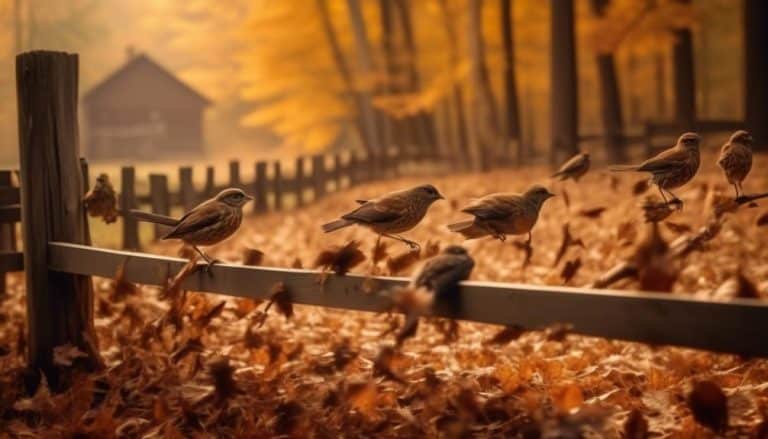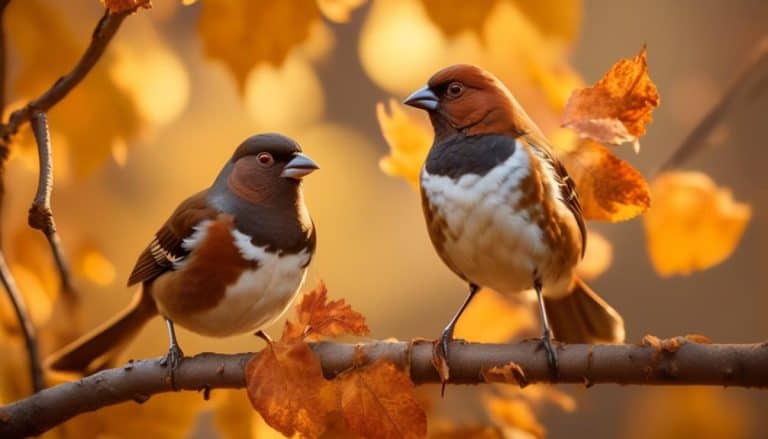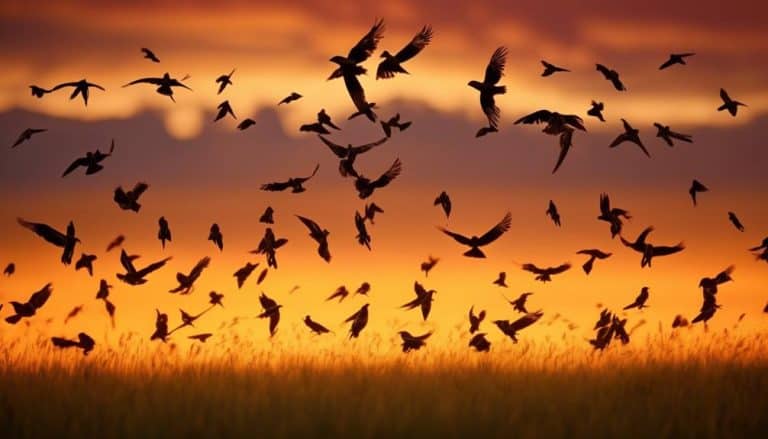A flash of vibrant yellow caught my eye as I sat in my backyard one summer morning, sipping my coffee and watching the world come alive. It was an American Goldfinch, gracefully perched on a sunflower, its feathers shimmering like rays of sunlight.
This encounter sparked my curiosity about the small birds that call Michigan home. What other delightful creatures are hidden among the trees and bushes, sharing their songs and stories with those who take the time to observe?
Little did I know there was a world of enchantment waiting to be discovered, and I invite you to join me on this journey of exploration and wonder.
The American Goldfinch: Michigan’s Colorful Icon

The American Goldfinch, a small, vibrant bird native to Michigan, is widely recognized as an iconic symbol of the state’s colorful bird species. The American Goldfinch stands out among the trees and bushes with its bright yellow plumage and black cap. As an avid birdwatcher, I’ve enjoyed observing these beautiful creatures in action.
Michigan’s birdwatching hotspots offer the perfect opportunity to witness the American Goldfinch in its natural habitat. These hotspots, such as the Seney National Wildlife Refuge and the Sleeping Bear Dunes National Lakeshore, provide diverse ecosystems for these birds to thrive in. The American Goldfinch is known to inhabit open fields, meadows, and woodland edges, making these areas ideal for spotting.
The American Goldfinch plays an important role in Michigan’s ecosystem. They’re primarily seed eaters and are particularly fond of thistle seeds. As they forage for seeds, they inadvertently help in the dispersal of these seeds, contributing to the growth and diversity of plant species in the area. Additionally, their bright yellow plumage serves as a visual attraction, aiding in the pollination of flowers.
The Song Sparrow: A Melodious Delight
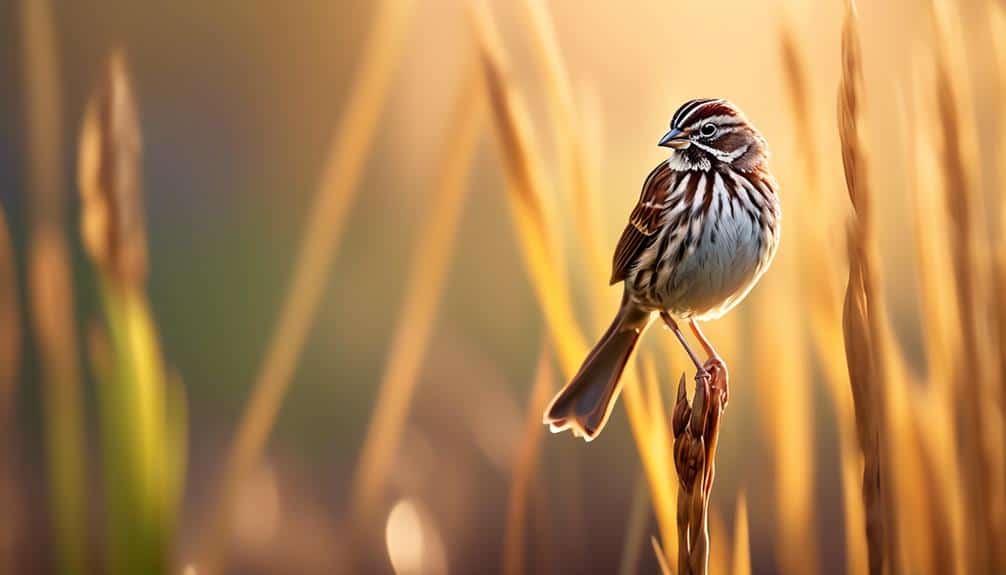
Observing the American Goldfinch in Michigan’s diverse habitats has sparked my curiosity about another small bird species that adds a delightful melody to the state’s avian chorus.
The Song Sparrow, scientifically known as Melospiza melodia, is a common passerine bird in Michigan. This small bird, measuring about 6-7 inches in length, possesses unique characteristics that make it a delight to observe.
- The Song Sparrow’s melodious song fills the air with a beautiful trill, consisting of a series of rich, musical notes.
- Its plumage varies, but most have brown streaks on a buff or white chest and a distinct dark spot on the breast.
- This species is known for its broad, rounded wings, which allow it to maneuver effortlessly through the dense vegetation where it often resides.
- The Song Sparrow’s diet primarily consists of seeds, insects, and small invertebrates, which it forages for on the ground or in low vegetation.
- Nesting close to the ground, the female Song Sparrow constructs a cup-shaped nest using grasses and twigs, often hidden among shrubs or grassy patches.
The Song Sparrow’s melodious song and unique characteristics make it a gem in Michigan’s avian community. Its presence adds an enchanting element to the state’s habitats, captivating birdwatchers, and nature enthusiasts alike.
The Eastern Bluebird: A Symbol of Hope and Happiness

As I explore Michigan’s diverse bird species, one avian gem that captures my attention is the Eastern Bluebird, a symbol of hope and happiness. The Eastern Bluebird, scientifically known as Sialia sialis, is a small migratory passerine bird that belongs to the thrush family. These vibrant blue birds are widely recognized for their stunning appearance and melodious songs, making them a favorite among bird enthusiasts.
The Eastern Bluebird holds great symbolic significance to many people. Its bright blue feathers and cheerful chirps are often associated with hope, happiness, and renewal. The bluebird has been adopted as the official state bird of Missouri and New York, further highlighting its importance as a symbol of positivity and optimism.
Unfortunately, the Eastern Bluebird population significantly declined in the early 20th century due to habitat loss and competition with other species for nesting sites. However, their numbers have rebounded thanks to dedicated conservation efforts in recent years. These efforts include the installation of nesting boxes and providing suitable habitats for the bluebirds to breed and raise their young.
Habitat conservation plays a crucial role in ensuring the survival of the Eastern Bluebird. They prefer open areas with scattered trees, such as meadows, orchards, and golf courses. By preserving these habitats and providing artificial nest boxes, we can continue to support the Eastern Bluebird population and enjoy their presence as a symbol of hope and happiness in Michigan and beyond.
The Black-Capped Chickadee: Michigan’s Friendly Neighbor
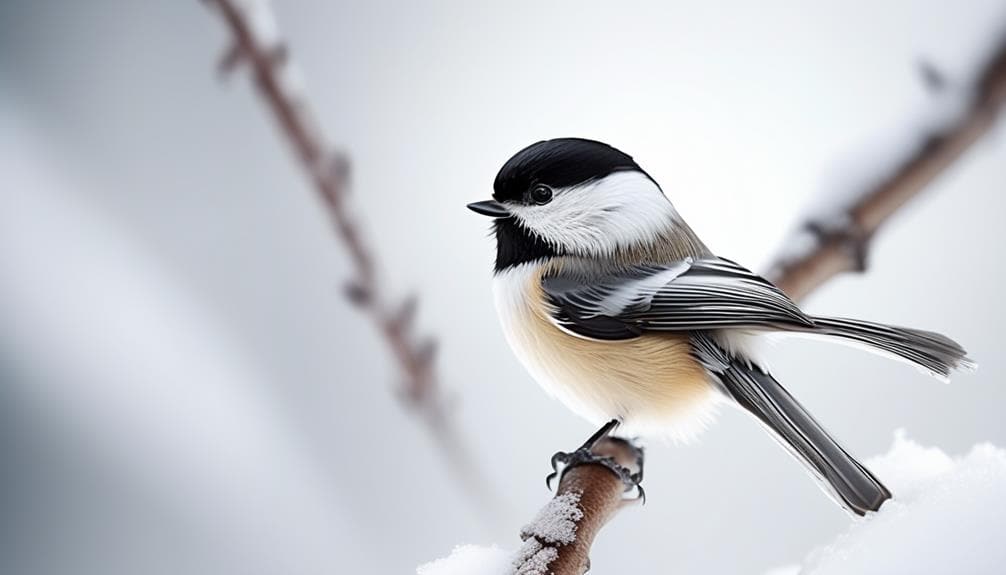
With its distinctive black cap and friendly demeanor, the Black-Capped Chickadee is a common and beloved resident of Michigan’s bird community. This small songbird, known for its cheerful ‘chick-a-dee-dee-dee’ call, never fails to bring joy to those who encounter it in the forests and woodlands of Michigan.
- In my observations, I’ve noticed that the Black-Capped Chickadee is an acrobatic flyer, effortlessly navigating through the dense canopy with its quick and agile movements.
- These little birds are known for their curious and sociable nature, often approaching humans with fearlessness.
- Michigan’s chickadees are highly adaptable and can be found in various habitats, from urban parks to remote wilderness areas.
- Regarding food preferences, the Black-Capped Chickadee has a diverse diet. They feed on insects, spiders, berries, seeds, and even small fruits.
- During winter, these resourceful birds cache food in tree bark crevices, allowing them to survive the harsh Michigan winters.
The Ruby-Throated Hummingbird: Nature’s Tiny Jewel

The Ruby-Throated Hummingbird, a remarkable and vibrant creature, captivates with its iridescent colors and astonishing flight capabilities. As a nature photographer, I have been fortunate enough to witness the beauty of these tiny jewels up close. Their emerald-green feathers shimmer in the sunlight, while the males boast a stunning ruby-red throat, which gives them their name.
One of the most fascinating aspects of the Ruby-Throated Hummingbird is its migration pattern. These birds travel incredible distances, flying non-stop across the Gulf of Mexico to reach their wintering grounds in Central America. It’s a perilous journey for such small creatures; their determination is awe-inspiring.
To highlight the uniqueness of these birds, I have created a table showcasing some interesting facts about the Ruby-Throated Hummingbird:
| Category | Fact |
|---|---|
| Scientific Name | Archilochus colubris |
| Size | 3-4 inches in length |
| Wingspan | Approximately 4-4.5 inches |
| Average Lifespan | 3-5 years |
Observing these birds and capturing their beauty through my camera lens has been a rewarding experience. The fast-paced flapping of their wings, which can reach up to 80 beats per second, allows them to hover in mid-air and even fly backward. Their agility and speed are astonishing.
The Ruby-Throated Hummingbird is truly nature’s tiny jewel, and I feel privileged to have the opportunity to witness and document their extraordinary behavior through nature photography.
The Cedar Waxwing: Michigan’s Fruit-Loving Beauty
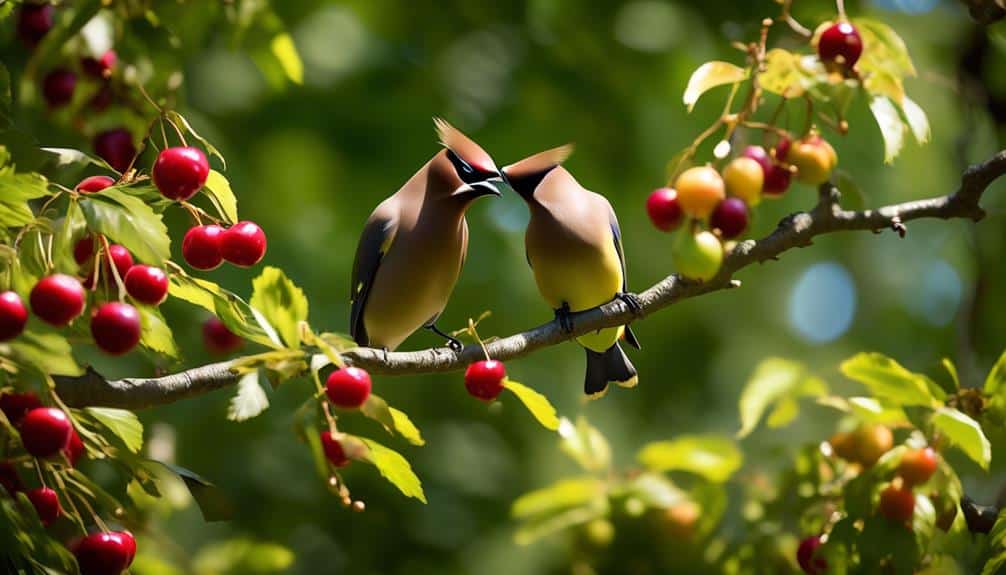
Having marveled at the remarkable flight capabilities of the Ruby-Throated Hummingbird, I now turn my attention to another avian beauty found in Michigan – the Cedar Waxwing, a fruit-loving marvel of nature. These small birds play a crucial role in Michigan’s ecosystem, contributing to fruit seeds’ dispersal and aiding in plant species’ regeneration.
Here are five characteristics that make the Cedar Waxwing truly unique:
- Sleek plumage: The Cedar Waxwing boasts a silky-smooth coat of brownish-gray feathers, with a distinctive crest on its head and a black mask around its eyes. Its wings are adorned with bright red tips and yellow accents, giving it a touch of elegance.
- Berry-loving diet: As its name suggests, the Cedar Waxwing has a penchant for fruit. It’s often seen perched in trees, feasting on various berries, including cedar, hawthorn, and juniper trees. This dietary preference makes it an important agent for seed dispersal throughout the Michigan ecosystem.
- Synchronized feeding: Cedar Waxwings are known for their social behavior, often gathering in large flocks to feed. They display remarkable coordination during feeding, taking turns plucking berries from the trees in an organized manner.
- Whistling calls: The Cedar Waxwing’s vocalizations are soft and high-pitched, resembling a gentle whistle or trill. These melodic calls are often heard during their feeding frenzy, adding a musical touch to the Michigan landscape.
- Migratory patterns: Like many birds in Michigan, Cedar Waxwings are migratory, traveling south during winter and returning to the state in the spring. Their arrival marks the beginning of a fruitful season, as they contribute to the pollination and seed dispersal of various plant species.
The ecological role of Cedar Waxwings in Michigan’s ecosystem is significant. By consuming fruit and distributing seeds, they aid in the regeneration of plant populations and contribute to the overall biodiversity of the region. As fruit-loving birds, they play a vital part in maintaining the delicate balance of Michigan’s natural environment.
Frequently Asked Questions
What Is the Average Lifespan of Small Birds in Michigan?
The average lifespan of small birds in Michigan varies depending on the species. These birds have adapted to the changing seasons, allowing them to survive and thrive in their natural habitats.
How Do Small Birds in Michigan Adapt to the Changing Seasons?
Small birds in Michigan adapt to the changing seasons through various adaptation strategies. They employ winter survival techniques such as migration, huddling together for warmth, and finding available food sources during the colder months.
What Are Some Common Predators of Small Birds in Michigan?
Small birds in Michigan face a variety of predators. Natural threats include birds of prey, such as hawks and owls, and mammals, such as cats and raccoons. Human activities like habitat loss also impact their survival.
Do Small Birds in Michigan Migrate, and Where Do They Go?
I’ve observed that small birds in Michigan do migrate. They travel to warmer regions during winter, seeking food and better conditions. However, climate change affects their migration patterns, causing disruptions in their journey.
How Do Small Birds in Michigan Communicate With Each Other?
Small birds in Michigan communicate through a combination of vocalizations and body language. Visual cues also play a crucial role in their communication. Observing how these small creatures interact and convey messages to one another is fascinating.
Conclusion
Sitting in my backyard in Michigan, I’m surrounded by a symphony of colors and melodies. The American Goldfinch flits through the air, its vibrant yellow feathers catching the sunlight. The Song Sparrow serenades me with its melodious song, filling the air with pure joy. The Eastern Bluebird perches on a nearby branch, a beacon of hope and happiness. The Black-Capped Chickadee hops from tree to tree, its friendly demeanor making me smile.
The Ruby-Throated Hummingbird hovers mid-air, a tiny jewel glistening in the sunlight. And the Cedar Waxwing, with its sleek plumage and fruit-filled beak, adds a touch of beauty to this natural paradise. Michigan is truly blessed with an abundance of small birds, each one a testament to the wonders of nature.


